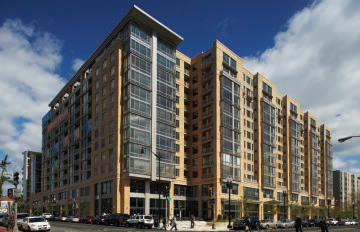In an article about Pioneering Projects, the Real Estate Forum highlights the CityVista project as one of the country’s most transformative urban mixed-used projects in recent history.
Newbie Washington, DC residents may find this hard to believe but at one point the city was widely considered to be just a drab company town—a place where commuters came to work and then left for nearby suburbs. Although this wasn’t true, the perception was unshakeable among many quarters until ambitious work-live-play projects started to come on line.
Chief among these has been CityVista, a 1.8-million-square foot mixed-use project in the Mount Vernon Triangle submarket that sports 244 apartment units, 441 condo units, 115,000-square feet of retail and a 828-space garage.
Developed by Lowe Enterprises, which teamed up with Bundy Development, CIM Group, Neighborhood Development Company as well as the local community, the project has completely repositioned Mount Vernon Triangle — and proven without a shadow of a doubt that people do indeed want to live and play in DC as well as work.
This was hardly obvious in 2004, when the Lowe Enterprises-led team was selected by the National Capital Revitalization Corp. to build the project. At that time, the area between 5th and K streets, NW, was quite underdeveloped, home to parking lots and troubled by vice activities. It took some vision to recognize the area’s potential despite its close proximity to Downtown and public transit.
The project delivered in 2008 just as the recession began—although admittedly the District and surrounding areas remained immune to its effects for some time. Still, Lowe Enterprise had little difficulty finding buyers for the project’s various components.
The retail component of CityVista sold in 2008. The apartment building sold in 2010. The final condominiums were sold in 2010. The office component is thriving as well: The District of Columbia’s Deputy Mayor’s Office of Planning and Economic Development remains the ground lessor of the property.
CityVista was also something of a trailblazer for affordable housing in the District. The project has three residential buildings totaling 685 housing units: The L with 149 condominiums; The K with 292 condominiums; and The V with 244 apartments. Twenty percent of the residences are affordable units for households earning between 30% and 80% percent of area median income.
However, CityVista delivered before the city had a formal ADU program in place and no database of qualified applicants was available. Lowe Enterprises, at its own expense, engaged a team of consultants and non-profit organizations to establish an outreach program, conduct an audited lottery program and provide assistance to the renters and buyers.
CityVista also brought community-serving retailers to the area with a 55,000-square-foot, 24-hour urban lifestyle Safeway grocery store and another 60,000 square feet of retail, restaurants and services. These convenience and specialty stores include Starbucks, Bergmann’s Dry Cleaning, VIDA Fitness, 5th Street Hardware, Chipotle, Taylor Gourmet deli and a bank, as well as the very popular Busboys and Poets restaurant.
The project also features a number of public spaces and common areas with landscaped courtyards and promenades. A sculpture by artist David Black can be found in front of Busboys and Poets and two other sculptures, Lift Off and Inspiration, were installed on the corner of 5th and K Streets in 2009 and 2010, respectively.
Not surprisingly, the project has gone on to win accolades from the community. Readers of the Washington City Paper named it the best residential property and the project won Delta Associates’ prestigious award for Best Mid-Atlantic Neighborhood Impact Condominium Community in 2007.
CityVista’s chief accomplishment, however, has been the impetus it provided to the Mount Vernon Triangle. Simply put, this part of town was able to reinvent itself in a short period of time thanks to CityVista. Today a vibrant urban core, the submarket has 1.7 million square feet of office, 3,689 units, 228 hotel rooms, and 260,000 feet of retail existing and under construction. — Erika Morphy


